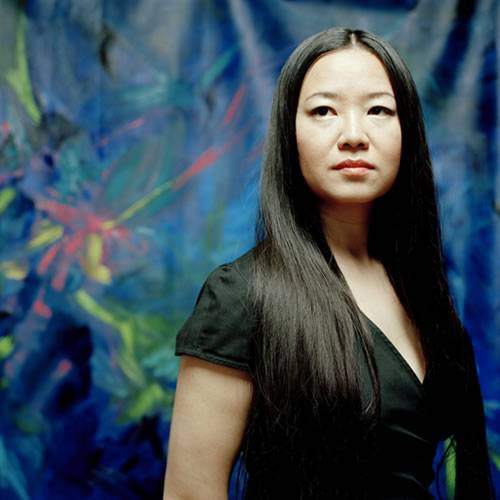The Girl Who Played Go (23 page)

Her only reply is to scream hysterically, “Kill me, please, I beg you. Kill me, don’t let me live!”
“Lieutenant,” Hayashi calls from the other side of the door, “you’re taking your time. Hurry up. Don’t be so selfish!”
I grab my pistol and I hold it to the Chinese girl’s temple. She looks up at me and there is no longer any fear in her eyes. I see the indifference she had always accorded to strangers.
I shudder and press my weapon a little more firmly.
“Do you recognize me?”
She closes her eyes.
“I know that you hate me, I know you can’t forgive me. At this moment, I couldn’t care less. I’m going to kill you and then myself afterwards. For your sake I’m going to turn my back on this war and betray my own country. For your sake I will shame my own parents, I will sully my ancestors’ honor. My name will be uttered only as a curse, never to be inscribed in the Temple of Heroes.”
I cover her in kisses and now I feel tears on her cheeks. And she lets me kiss her.
The ground trembles as the men drum it with their rifle butts.
“Lieutenant? I’m going to count to three! One…”
There is no time to ask her why she left her country, why she cut her beautiful hair. I have a thousand questions for her but I’ll never learn the answer to a single one of them.
“Two…”
“Don’t worry,” I whisper in her ear, “I’ll follow you. I’ll care for you in the afterlife.”
She opens her eyes and stares at me:
“My name is Song of the Night.”
But I have already pulled the trigger. Her dark eyes quiver, her pupils dilate, the blood spurts from her temples. With her eyes still wide open, she falls backwards to the ground.
The door opens and I can hear footsteps behind me. I realize with despair that I don’t even have time to cut open my entrails as would befit a samurai.
I put the blood-splattered pistol into my mouth.
A loud noise, the ground trembling beneath my feet.
I fall onto the girl who played go. Her face looks pinker than it did earlier. She is smiling.
I try very hard to keep my eyes open so that I can look at my beloved.
About Shan Sa
Shan Sa was born in Beijing, China, to a scholarly family. Her real name is Yan Ni Ni; she adopted the pseudonym Shan Sa, taken from a poem by the Tang dynasty poet Bai Juyi. At age 8, she published her first poetry collection, and went on to obtain the first prize in the national poetry contest for children under 12 years, an event that created a public upheaval. After graduating from secondary school in Beijing, she moved to Paris in August 1990 thanks to a grant by the French government. Settling there with her father, a professor at the Sorbonne University, she quickly adopted the French language. In 1994, she finished her studies of philosophy. From 1994 to 1996 she worked as a secretary of painter Balthus. Thereafter she published her first two novels and a collection of poetry, meeting with great critical acclaim. In 2001 she reached the top of her success with the publication of her most famous book so far, "The Girl Who Played Go" (a.k.a La Joueuse de Go). The book received good feedback from readers and was awarded a number of prizes, including the Prix Goncourt des Lycéens (Prix Goncourt of the High-school students).

[1]
“Mother,” in respectful Japanese.
“Mother,” in respectful Japanese.
[2]
Pu-Yi, the last Emperor of China. He abdicated when the Chinese Republic was created in 1912. In 1932, with Japanese help, he fled from Tian Jing, where he had been living under guard. In order to legalize their occupation of northern China since September 18, 1931, the Japanese then put him on the throne of Manchuria and proclaimed its independence in March 1932. †Xin Jing, the capital of independent Manchuria, which is now the town of Chang Chun.
Pu-Yi, the last Emperor of China. He abdicated when the Chinese Republic was created in 1912. In 1932, with Japanese help, he fled from Tian Jing, where he had been living under guard. In order to legalize their occupation of northern China since September 18, 1931, the Japanese then put him on the throne of Manchuria and proclaimed its independence in March 1932. †Xin Jing, the capital of independent Manchuria, which is now the town of Chang Chun.
[3]
On December 12, 1936, Zhang Xueliang took Chiang Kai-shek hostage. He freed him on December 25 and accompanied him back to Nanking, where the Kuomintang-the popular democratic party in China -was based. As they stepped off the airplane, Chiang broke their agreement and imprisoned Zhang for some fifty years.
On December 12, 1936, Zhang Xueliang took Chiang Kai-shek hostage. He freed him on December 25 and accompanied him back to Nanking, where the Kuomintang-the popular democratic party in China -was based. As they stepped off the airplane, Chiang broke their agreement and imprisoned Zhang for some fifty years.
[4]
On September 18, 1931, the Japanese army defeated Zhang Xueliang’s troops and took over Manchuria.
On September 18, 1931, the Japanese army defeated Zhang Xueliang’s troops and took over Manchuria.
[5]
From 1905 to 1910 Japan succeeded in driving Russian and Chinese forces out of Korea, then it colonized the peninsula, enforcing the use of the Japanese language and instigating a policy of cultural assimilation.
From 1905 to 1910 Japan succeeded in driving Russian and Chinese forces out of Korea, then it colonized the peninsula, enforcing the use of the Japanese language and instigating a policy of cultural assimilation.
[6]
As Manchuria is often called “the country outside the Great Wall,” the areas inside the Great Wall are also known as the “inner territories.” In 1932, when Manchuria became independent, the Japanese instituted a system of passports so that they had more control over movements between the zone that was under their influence and the rest of China.
As Manchuria is often called “the country outside the Great Wall,” the areas inside the Great Wall are also known as the “inner territories.” In 1932, when Manchuria became independent, the Japanese instituted a system of passports so that they had more control over movements between the zone that was under their influence and the rest of China.
[7]
From the sixth century Buddhism and Chinese culture infiltrated the Yamato Imperial court of Japan. In 604 Prince Shotoku sent an official embassy to the court of Chang’an (now Xian) in China. In 645 the Yamato court decided to turn Japan into a copy of Tang China, and Japanese calligraphy adopted Chinese ideograms. The political problems within the Tang court, and the Tatar invasion, persuaded the Japanese to withdraw their embassy in 838. From then on Japanese culture has evolved independently from that on the Chinese mainland.
From the sixth century Buddhism and Chinese culture infiltrated the Yamato Imperial court of Japan. In 604 Prince Shotoku sent an official embassy to the court of Chang’an (now Xian) in China. In 645 the Yamato court decided to turn Japan into a copy of Tang China, and Japanese calligraphy adopted Chinese ideograms. The political problems within the Tang court, and the Tatar invasion, persuaded the Japanese to withdraw their embassy in 838. From then on Japanese culture has evolved independently from that on the Chinese mainland.
[8]
Tokugawa’s family produced fifteen shoguns, who reigned over Japan from the beginning of the seventeenth century to the end of the nineteenth century.
Tokugawa’s family produced fifteen shoguns, who reigned over Japan from the beginning of the seventeenth century to the end of the nineteenth century.
[10]
In Japan apprentice geishas wear wide sleeves. Once their status as geishas is confirmed, they wear narrow sleeves.
In Japan apprentice geishas wear wide sleeves. Once their status as geishas is confirmed, they wear narrow sleeves.
[11]
Manchurian hierarchy is classed in order according to different-colored banners that represent the various clans. Pure yellow is the color of the clan that counts the imperial family among its descendants.
Manchurian hierarchy is classed in order according to different-colored banners that represent the various clans. Pure yellow is the color of the clan that counts the imperial family among its descendants.
[12]
On May 15, 1932, nine officers managed to get into Prime Minister Inukai’s residence. They assassinated him before handing themselves over to the police.
On May 15, 1932, nine officers managed to get into Prime Minister Inukai’s residence. They assassinated him before handing themselves over to the police.
[13]
The Kamakura era: 1192-1333. While the Emperor continued to preside over a symbolic court in Kyoto, the shogun in Kamakura actually wielded power over the entire country.
The Kamakura era: 1192-1333. While the Emperor continued to preside over a symbolic court in Kyoto, the shogun in Kamakura actually wielded power over the entire country.
[14]
A form of suicide accessible only to samurais (and, therefore, only to men). It follows a precise ritual: death is achieved by disembowelment with a small saber.
A form of suicide accessible only to samurais (and, therefore, only to men). It follows a precise ritual: death is achieved by disembowelment with a small saber.
[15]
In the theater of Noh, Kyogens are comic performers who appear between two acts of the play.
In the theater of Noh, Kyogens are comic performers who appear between two acts of the play.
[16]
In the game of go the black stones begin the game, but they have to concede 5½ points to the whites in the count-up when the game is over.
In the game of go the black stones begin the game, but they have to concede 5½ points to the whites in the count-up when the game is over.
[17]
Chinese philosopher (360? BC-280? BC), the founder of Taoist thinking.
Chinese philosopher (360? BC-280? BC), the founder of Taoist thinking.
[18]
A wide belt used by the Japanese to secure a kimono.
A wide belt used by the Japanese to secure a kimono.
[20]
From a poem by Issa, an eighteenth-century Japanese poet.
From a poem by Issa, an eighteenth-century Japanese poet.
[21]
Poem by Li Yu, China, tenth century.
Poem by Li Yu, China, tenth century.
[22]
Poem by Li Po, China, eighth century.
Poem by Li Po, China, eighth century.
Other books
Web of the City by Harlan Ellison
Changeling: Zombie Dawn by Steve Feasey
Butterflies in Heat by Darwin Porter
Avalon: The Retreat by Rusin, L. Michael
Hate at First Sight by Nixon, Diana
The Unforgiven by Joy Nash
Enough About Love by Herve Le Tellier
Keeper: First Ordinance, Book 2 by Suttle, Connie
Demons Don’t Dream by Piers Anthony